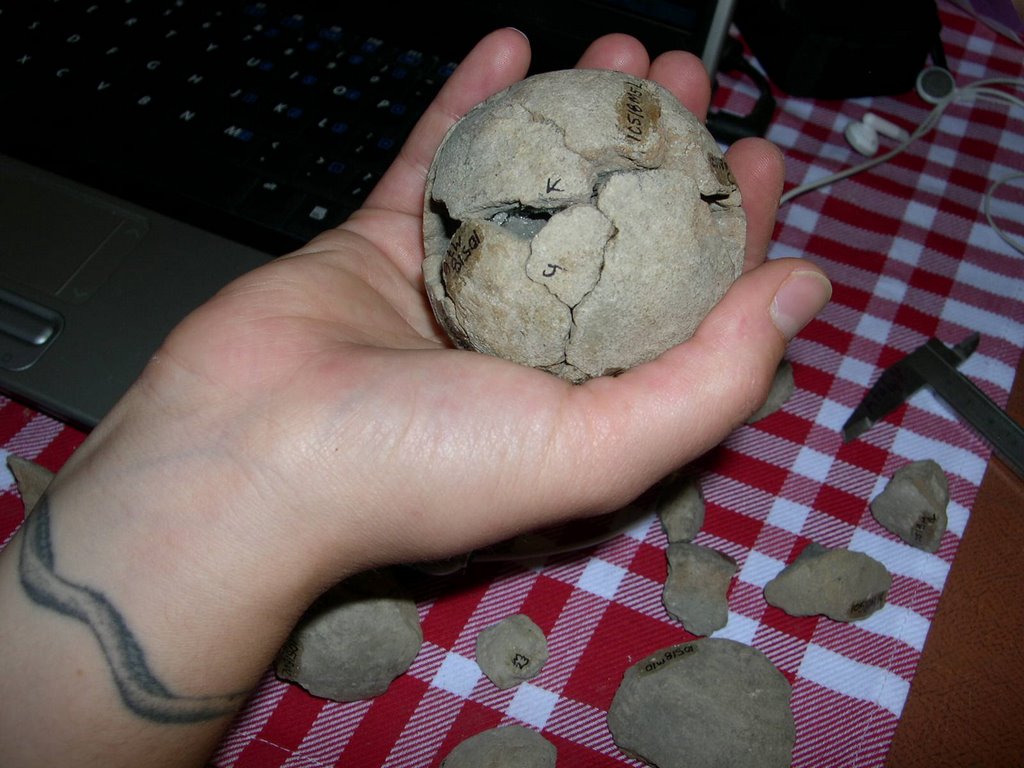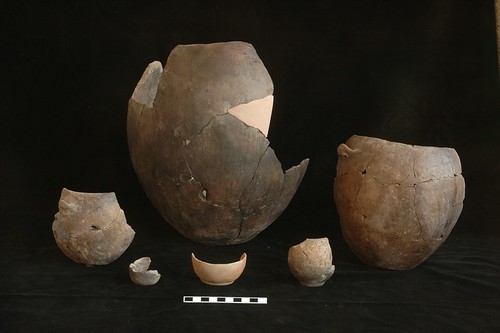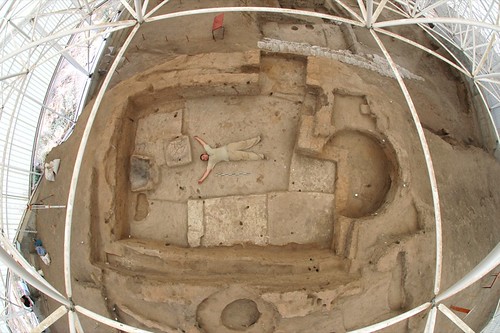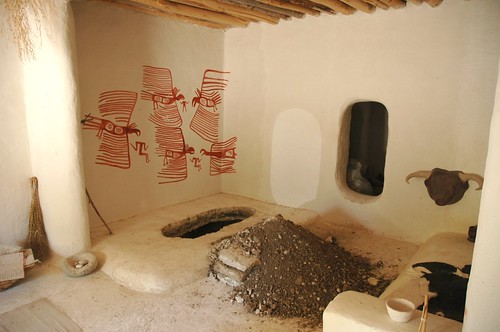extract:
At Çatalhöyük, a Neolithic site in Turkey, families packed their mud-brick houses close together and traipsed over roofs
to climb into their rooms from above.
Çatalhöyük was first identified and excavated in the late 1950s and early 1960s by the English archaeologist James Mellaart. His excavations revealed fourteen levels of occupation in the larger mound, created as people tore down old houses, filled them in, and built new ones on top. Altogether, Mellaart excavated about 160 buildings, spread over the various levels. Each building probably housed a family of between five and ten people. One main room was the locus of family living, cooking, eating, craft activities, and sleeping, and there were side rooms for storage and food preparation.
Wall painting, some 8,500 years old, was discovered by the English archaeologist James Mellaart in the 1960s, during his excavations of the Turkish site of Çatalhöyük. In Mellaart’s interpretation of the painting, the foreground shows a town, possibly Çatalhöyük itself, with the eruption, in the background, of a twin-peaked volcano, perhaps Hasan Dag( (see map below). Mellaart’s reconstruction of the painting appears at the head of the article.
Mellaart’ s excavations turned up evidence that the people of Çatalhöyük made use of domesticated plants and animals. The finding excited wide interest, because it meant that very early farming villages grew up not only in the Levant and adjacent areas of the Middle East, where wild plants and animals were first domesticated, but also here, in Anatolia. But even more astonishing were some other distinctive characteristics of Çatalhöyük that Mellaart was the first to describe. The houses of Çatalhöyük were so tightly packed together that there were few or no streets. Access to interior spaces was across roofs—which had been made of wood and reeds plastered with mud—and down stairs. People buried their dead beneath the floors. Above all, the interiors were rich with artwork—mural paintings, reliefs, and sculptures, including images of women that some interpreted as evidence for a cult of a mother goddess.
Çatalhöyük was quite large for a town of Neolithic age—the time from about 11,500 to 8,000 years ago, when people began living in relatively permanent villages and making use of domesticated crops and animals. The population fluctuated between 3,000 and 8,000; in physical area the large mound encompassed some 33.5 acres. Unsurprisingly then, despite excavating for four years, Mellaart uncovered only a small part of the town. The current dig, which I direct, has excavated or determined the outlines of eighty more buildings and has identified four additional levels of occupation in the larger mound. Yet as I walk over that mound, I am well aware that thousands of buildings are still hidden beneath the soil, full of art and symbolism, waiting to be explored.
Archaeologists do know a lot more now than they did at the time of Mellaart’s discovery about other Anatolian settlements dating from the Neolithic. But for any student of that era—myself included—Çatalhöyük and its mysteries hold a special appeal. What led to the concentration of art in so many houses at one site? Why was the settlement so large—what drew people to that particular place? And how much can be learned from what is perhaps the most intriguing feature of all about Çatalhöyük: that the site was built and rebuilt over the centuries in ways that provide an unusually rich record of the minutiae of daily life?
These photos accompany the article.



The website for the dig, Çatalhöyük Homepage gives a bit more information and some useful links, one to an exhibition on view this summer in Istambul, and another to a photo album on flickr.
 There's also a excavation blog, giving the personal experiences of six young people working at the site during the summer months. This image comes from the blog and shows a "face-pot" excavated this summer.
There's also a excavation blog, giving the personal experiences of six young people working at the site during the summer months. This image comes from the blog and shows a "face-pot" excavated this summer.
This is a drawing by an artist blogger, John S.

The blog says this is "Sonya with a reconstructed clay ball." Clay balls were used in cooking. They were heated and then put in liquids to make them boil or used on the hearth to cook meat.
Here are a few of the many flickr photos:

Neolithic pottery.

The caption reads: "Fisheye overhead shot of Building 56 in South Area of excavation. Candemir Filling in as a scale."

This shows the interior of an experimental house built to show what a typical neolithic one looked like.




No comments:
Post a Comment